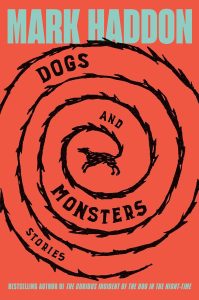Doubleday
Review by Walter Cummins

The seven stories in Monsters and Dogs were written over a long period, their composition interrupted by Haddon’s triple heart bypass. That time span may be the reason they are each so different even though most have their origin ideas in classic myths. Yet despite that similarity, each story is a unique creation, a fully imagined narrative that transforms the source myth into a distinctive reality as richly developed as a detailed novel. The fundamental reason for that is the writing. Few authors have Haddon’s command of language. The words covey much more than information, building a complex reality alive with emotional resonance.
One essential test Haddon has given himself is capturing the extremes of the painful or shocking experience endured by many of the characters. One of the most excruciating is the description of the transformation of man into stag that Actaeon suffers in “D.O.G.Z.” as punishment for viewing a group of naked maidens at a pond, the powerful goddess Diana among them, who asserts that “You have seen what no man should ever see.”
He feels branded by these words when the women mock him with laughter as he begins to feel the inner upheaval of his human form: “A sudden pain folds him in two. Something terrible is happening inside his body, as if another man has been stitched inside him and is fighting his way out of this cramped and bloody prison. His spine straightens before arching backwards in a violent rictus.” A full description of the agonizing step by step process of man to stag follows.
Then when he returns to the gathering his human companions, his dogs, identified by name, whom he loved and who loved him, regard his new form as that of a stag to be hunted as prey, These former pets tear him to pieces: “There is a spray of blood as the treasure chest of his belly is opened up, Hunter and Storm forcing their snouts in among the packed, wet organs, other claws and teeth pulling the skin back to widen the opening so that they can all feast.”
As the story continues, Hammond goes on to include many other dogs of literature—the Hound of the Baskervilles, David Copperfield’s Jip, Elizabeth Barrett’s Flush, RCA’s Nipper, Snoopy, and more that have comforted human owners—concluding with Laika, the Russian dog first in space, who realizes she is strapped into a canister that gets hotter and hotter, she longing for her canine companions, howling, frantically scratching the metal, dying during the space capsule’s fifth revolution, then having her body circulate the globe another two and a half thousand times until the satellite burns and disintegrates. She vanishes much like the remains of Actaeon.
“The Wilderness” opens with a woman named Tegan who has been cycling through days of unbroken forest, having a tire hit a rut, she ending up thrown over the handlebars, lying with a piercing pain the makes her long for death: “There is a violent fizz which is unlike anything she has experienced before, not wholly a noise nor wholly a bodily sensation, then the world disintegrates into scratches and blocks like the picture on an old television screen when the aerial loses the signal. She goes blind, the pain sweeps through her like fire through corn and she blacks out.”
Rather than a myth, this story was inspired by the H. G. Wells novel The Island of Dr. Moreau. A fully myth-based story is “The Quiet Limit of the World” that Haddon calls a reworking of the Greek myth of Tithonus. Eos, the goddess of dawn, after falling in love with a mortal human asks her father, Zeus, to grant him eternal life. But she forgets to add eternal youth. The loved man will not die, but the life around him will die, the goddess visiting him every morning of his unending life, caring for him as his physical body withers from centuries of age.
He lives through the events of human history, fights in wars, and has many human relationships, then weakening and weakening until he lies helpless in a hospital: “It is many years since he looked into a mirror but the image is not one he will easily forget—solar keratoses, spider veins, warts like fat black beetles, archipelagos of brown lesions. His tissue-paper skin is decorated with scars which cover almost every part of his body like runes from some wild, forgotten language.” And then, one day, as the story ends, his nurse cannot see him, only a grasshopper-like creature that leaps over a window frame and is gone.
These pains and disintegrations are monstrous as are the pains human are capable of imposing on others. Even the dogs that are so loving can turn into monstrous predators. Haddon, regardless of the tales behind these stories, possesses the inventive powers and the command of dramatic language to give new complex life to his reinventions.
